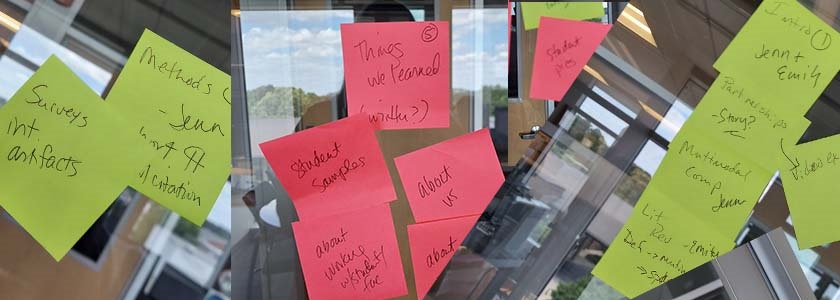Emily and Jenn believed that the collaboration was working well, and that students, faculty, and library staff were engaging in the instruction and creation of a multimodal product. Like many projects that stem from our own work in writing program administration and library studies' reflection and assessment, answering this question is rooted in ethnographic methods. We prepared a brief electronic survey of ENGL 1020 faculty, asking them to self-report their opinions and experiences with both multimodal composition and the Studio support.
In spring 2020, we applied for Institutional Review Board (IRB) approval (IRB Exempt #20-022) before sending out our surveys because Jenn's history of work in institutional ethnography had taught her to get IRB approval for almost everything, just in case. Our survey inquiry began with a few very simple questions asking faculty to detail their experience with multimodal composition prior to Jenn's hire as WPA. Our goal was to see how faculty felt about the incorporation of this new initiative and how the Studio factored into their work in it; any responses would inform revisions and changes to the partnership as it moved forward.
In March 2020, our entire project was put on hold. By February 2021, we'd realized that we wanted to collect more data, specifically instructor and student interviews, as well as some student samples, to offer more elaboration on the information we'd uncovered in our initial survey. Additionally, because many instructors didn't engage with the survey in early 2020, we wanted to resend the survey to faculty. One faculty member who had agreed to be interviewed mentioned this project to her students, who asked to participate as well. To that end, we revised and amended our IRB in February 2021 to collect additional student interview and project sample data.
Data Collected
Twenty-seven faculty responded to the survey. From the survey, we selected six faculty participants to participate in video interviews that asked them to elaborate on their answers (interview questions). A total of ten first-year composition students from one instructor's class were also interviewed about their opinions and experiences in multimodal composition.
Survey results were coded using in vivo coding to generate themes for our findings as well as to direct the interview questions for both faculty and students. Interview transcripts were then also coded using in vivo coding (Saldaña, 2021).
Interview questions followed two lines of inquiry: How is multimodal work happening in ENGL 1020? And, how is the Studio supporting that work? These two lines of inquiry were developed to (a) help Jenn assess how the multimodal instruction was happening or growing in the program and (b) help Emily determine how the Studio was being used by writing faculty.
To address the first line of inquiry, faculty were asked to describe their pedagogical approach to ENGL 1020 and how they defined multimodal composition. They were asked what they felt students learned from the project and to describe their experiences with it. Finally, they were asked if they've revised their multimodal project and to discuss why or why not.
To address the second line of inquiry, faculty were asked to describe the support they sought out for multimodal instruction, to describe their experience at the Studio and to indicate how, if at all, the support received and quality of student projects changed since the Studio opened.
We hoped that the faculty answers to these questions would inform programmatic changes in the Composition Program, garner more support for the Studio at the library, and help the librarians structure their instructional design to be most useful.
